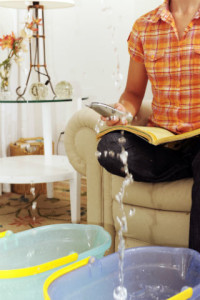 Flood Damage Restoration refers to:
Flood Damage Restoration refers to:
Flood damage resulting from accidental discharge, leakage, or overflow of water from plumbing systems, heating, air conditioning, and refrigerating systems, rain or snow through broken doors, open doors, windows, leaking roofs and skylights resulting in damage or destruction of your residential or commercial property. Water damage can show up in your building as something as minor as water spots on ceilings and walls to something as catastrophic as flooding. It is an issue that, if not taken seriously and treated immediately, can lead to increasing damage every hour of its existence as the minutes leak by.
How much damage can water cause?
Often times, people don’t understand how large of an impact a small leak can have on a home or building. There are numerous health risks associated with water damage. In addition, water leaks and flooding can permanently damage a building’s structure. Flood damage restoration involves removing the water, assessing the damage to contents and structure and carrying out the restoration.
Flood damage restoration is typically determined by the three water categories: Clean Water, Grey Water, and Black Water.
Clean Water refers to a source of water that is not substantially threatening to humans. Breaks in water supply lines, Tub or sink overflows or appliance glitches often fall under this category.
Grey Water refers to a source of water containing a substantial amount of contaminants. These contaminants are mostly chemical, biological, or physical and are likely to cause sickness after exposed or consumed. Toilets with urine (no solid waste), discharge from dishwashers and washing machines are common issues associated with grey water damage.
Black Water category refers to exceptionally unsanitary contamination from water sources that affects the indoor environment. In this category that we see fungus and bacteria contaminating indoor water sources.
Black water intrusion includes water sources from sewage, seawater, rising water from rivers or streams, ground surface water or standing water. When exposed to, Black Water damage can lead to severe illness.
Grey Water that is not promptly removed from the structure and or have remained stagnant for 48–72 hours may be re classified as black water. Toilet back flows that originates from beyond the toilet trap is considered black water contamination regardless of visible content or color.
If you are experiencing flooding and potential water damage it is essential that you contact us immediately so that we can send out our team of specialists to inspect your home to minimize water damage and begin flood damage restoration.